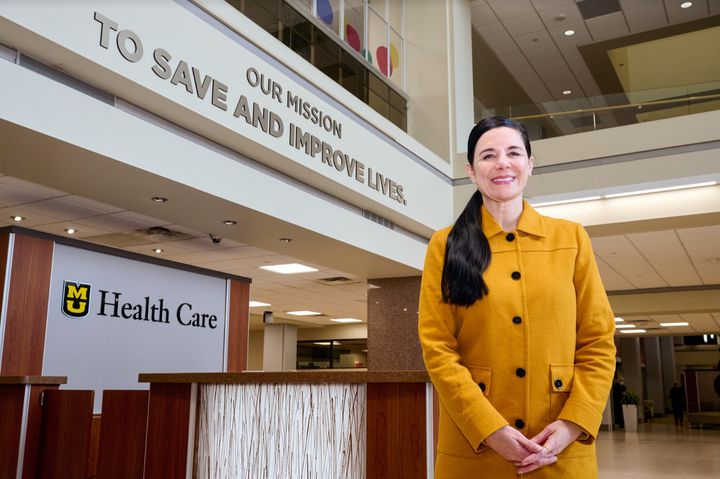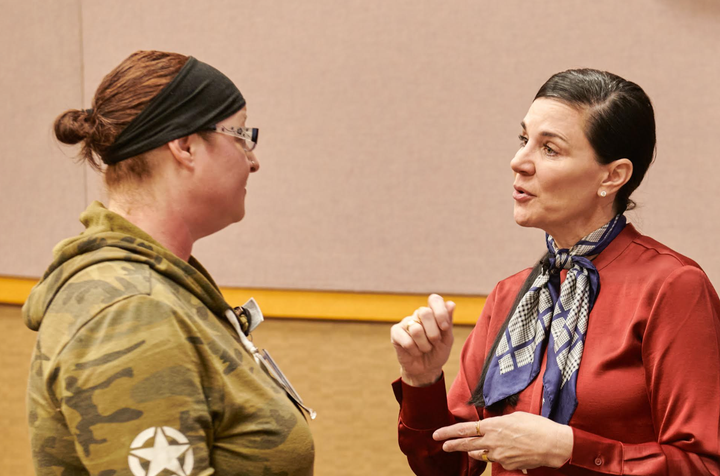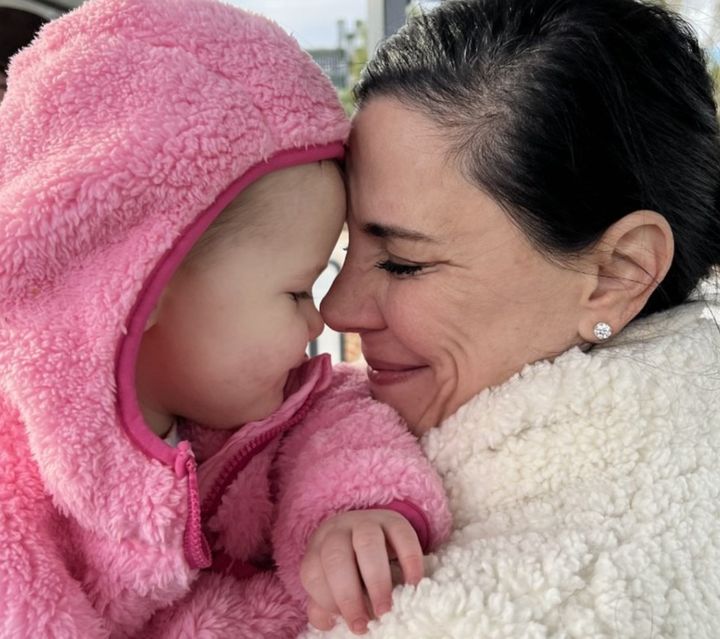
Earlier this year, as I walked into the University of Missouri Hospital, I wiped my sweaty palms on my jeans. I felt unsteady amid flashes of memories of ambulance lights, hospital gowns, and being handed a bag with the clothes that had been cut from my body. I read the words that hung on the wall — “Our Mission: To Save And Improve Lives.” One of the lives that hospital saved was my own.
I was there to speak to their emergency room medical residents about my patient experience. I walked into the conference room and there stood Jenn, the ER nurse I had spent years searching for.
I had checked Facebook, Instagram and Twitter, to no avail. I’d typed her name into Google and found many Jenns with her last name, but none of them was her. One of the administrators at the university was finally able to locate her for me.
Eight years ago, when I was rushed to that very ER after my suicide attempt, it was Jenn who helped pump pills out of my stomach. She poured charcoal down my throat and filled my veins with IV fluid to neutralise the effects of the pills. As she helped save my life, a bond of hope was sealed between us, and it would last for years to come.
I ran and hugged her, and she smiled. “I’m glad you’re still with us.”
“I’m glad, too,” I responded.

For my talk at the ER department, I had made a massive poster with photos of my life since my suicide attempt. Photos of me attending all three of my children’s weddings and holding my first granddaughter. Photos of me doing mental health advocacy work with first responders, veterans, and women in prison. Photos of me giving keynote speeches and making national TV appearances. My award-winning memoir. Photos of all the things I would have never experienced had the hospital not saved me.
Yet, that poster was missing the other part of my life.
There were no snapshots of my panic attacks or of the sleepless nights spent shaking, crying and pacing every room of my house for hours. I don’t have photos of the hot showers at 2 in the morning, or of praying on my hands and knees begging for God to give me relief, or my recent terrifying five-hour screening for electric shock treatment that is now part of my suicide prevention plan. What I told Jenn was the truth, because some days I’m glad I’m still here, but I still have days when I wish she and her colleagues hadn’t saved my life.
Many people applaud me for having conquered suicide ideation, but that isn’t actually what I did. I survived my suicide attempt, but I still have suicidal episodes. They are to be lived with — not conquered. Suicidal ideation can be treated through prevention, intervention, support strategies and suicide prevention plans. I’m not alone — many people who seek treatment for anxiety, depression, or eating disorders struggle with suicidal thoughts and urges.
Two weeks after I returned home from Missouri, I went into another deep suicidal episode.
As I taught a Sunday school class about trials, a woman asked if I would trade my trials for someone else’s, and I hesitantly replied, “Sure.”

Religiously speaking, it was the wrong answer.
“You would trade with someone who is dying?” she asked. As a mental health advocate, I felt the pressure to be an inspiring example of a suicide survivor. I knew what I was not allowed to say, yet I felt the truth rising in my voice.
“Yes,” the words slipped out, “I want to die.” She gasped. The entire room went silent.
It scares people to talk about suicide. The number-one myth is that if we talk about suicide, it will lead to and encourage suicide. That is false.
Suicide is a complex issue that can include many contributing factors, including bullying, prejudice or stigma around a person’s race, gender, disability or sexual identity. What makes people want to end their lives can be sexual or physical abuse, addiction, financial difficulties, relationship problems, long-term illnesses, or cultural and social pressures, as well as mental illnesses and lack of mental health resources, of course. Each of these situations can make a person feel isolated, inadequate, hopeless and silenced.
Every 40 seconds, a person dies from suicide. Suicide is the second-leading cause of death for Americans ages 10-14 and 20-34. Suicide is a leading causes of death for people across the United States.
In 2004, my father attempted to die by suicide. My brother and sister found him in time, and he lived only seven years more: He experienced a bipolar episode and died by suicide. The ever-present guilt of what more I could have done to save him still haunts me. I often wonder, if he and I had talked — really talked — about our suicide ideation, whether he would be alive today.
Some studies estimate that a single suicide loss impacts the lives of 135 different people.
The widespread suicidal ideation among teenage girls — nearly one-third of female high school students reported in 2021 that they had recently considered suicide — is extremely concerning and catastrophic, because it coincides with a national disinvestment in mental health care. Even before the COVID-19 pandemic, mental health care inequities in the U.S. resulted in more than 100,000 deaths and cost the economy about $278 billion over a four-year period.

I am one of the lucky ones who receives proper mental health care. It would be terrifying — and most likely fatal — for me to go without the support of mental health professionals.
My dialectical behavior therapist taught me that two truths can coexist: We can be lost and found, or in despair and hopeful, all at the same time.
My two truths in that Sunday school class were that I wanted to live — and I wanted to die.
As a mental health advocate, I have been terrified to admit that second truth out of fear that I would be stealing hope away from people who desperately need it. But I now believe I would be taking hope away from them if I didn’t share the whole picture.
Relapsing into another suicidal episode makes it’s hard not to question if I have somehow failed. But finding the strength to live another day takes courage. Surrendering to the reality that many will struggle with suicide ideation more than once, and for some like me, potentially for the rest of our lives — that is where hope lives. Hope is a choice to surrender to what “is” in that moment, knowing that dark times do not last forever and there are more joyful moments for us to experience.
Jenn later texted me, “To know and understand and feel that I was valuable and important to you, just the way you were and are to me that day and every day forward, was an amazing feeling I hadn’t felt in almost two decades of nursing.” It was a reminder that each of us is valuable not just in the sense of our individual worth, but in relation to each other.
The one thing we can all do to help prevent suicides is having open and inclusive conversations with our families, friends, co-workers and students, and in our communities, where people can share their unique experiences without feeling ashamed or broken. This expands our collective understanding of suicide by hearing different perspectives, and creates a more supportive environment for those struggling.
Suicide is not inevitable for anyone. Talking openly about suicide leads to more people seeking help for their mental health, which reduces the risk of suicide.
This is how we save lives.
Sonja Wasden is a suicide survivor with over 30 years of lived experience with mental health challenges. Her award-winning memoir, “An Impossible Life,” which details her struggles with mental illness, was featured on “CBS This Morning” as a story of hope. She is a member of Newsweek Expert Forum and has traveled the country speaking with Fortune 500 companies, not-for-profit organizations, government officials, advocacy groups and top media outlets about the importance of mental health. She has been an op-ed contributor for Oprah Daily, The Washington Post, Newsweek, The Hill, Ms. Magazine and the National Alliance on Mental Illness, among others. Sonja has been interviewed over 50 times on local and national news about the importance of raising mental health awareness. She has had the privilege of sharing her story and message of hope with millions of people.
Help and support:
- Mind, open Monday to Friday, 9am-6pm on 0300 123 3393.
- Samaritans offers a listening service which is open 24 hours a day, on 116 123 (UK and ROI - this number is FREE to call and will not appear on your phone bill).
- CALM (the Campaign Against Living Miserably) offer a helpline open 5pm-midnight, 365 days a year, on 0800 58 58 58, and a webchat service.
- The Mix is a free support service for people under 25. Call 0808 808 4994 or email help@themix.org.uk
- Rethink Mental Illness offers practical help through its advice line which can be reached on 0808 801 0525 (Monday to Friday 10am-4pm). More info can be found on rethink.org.